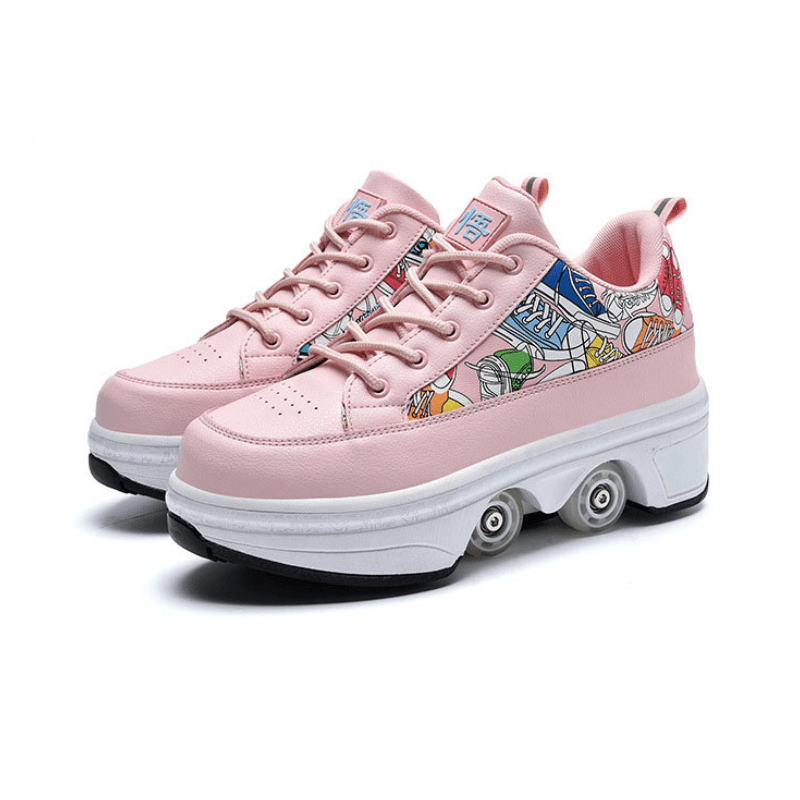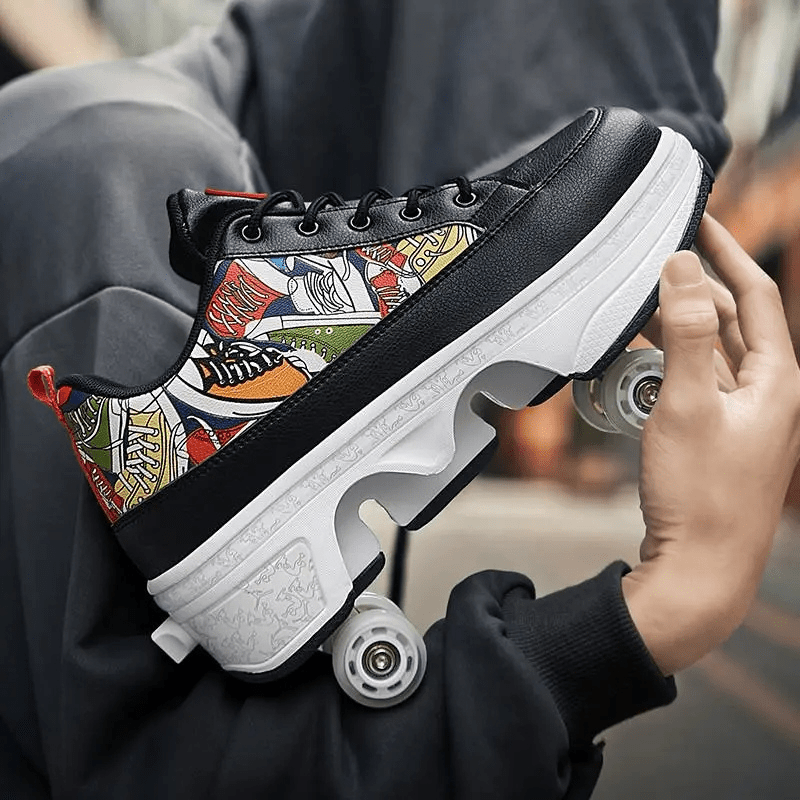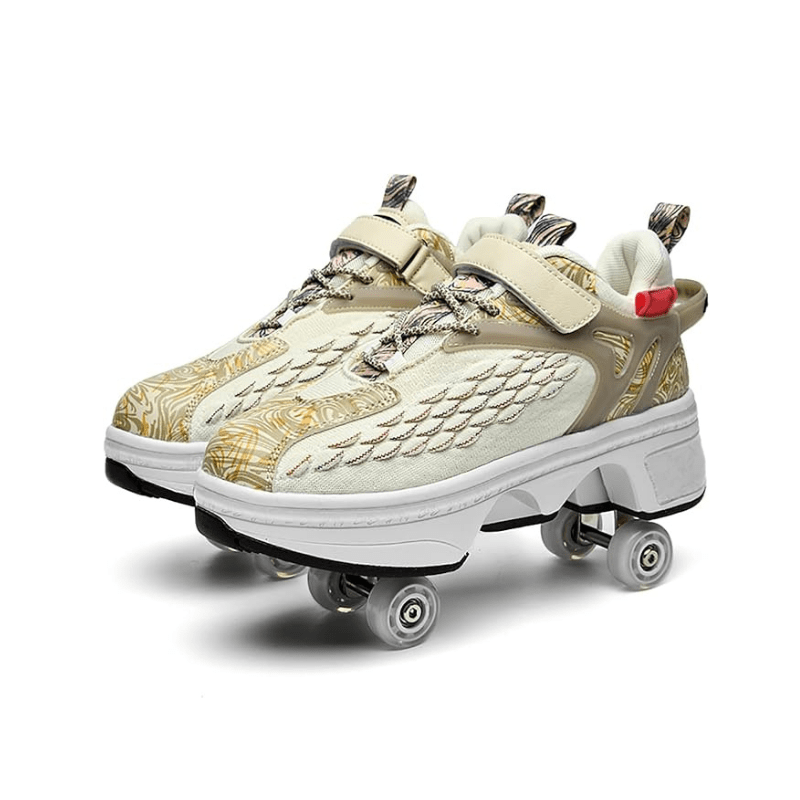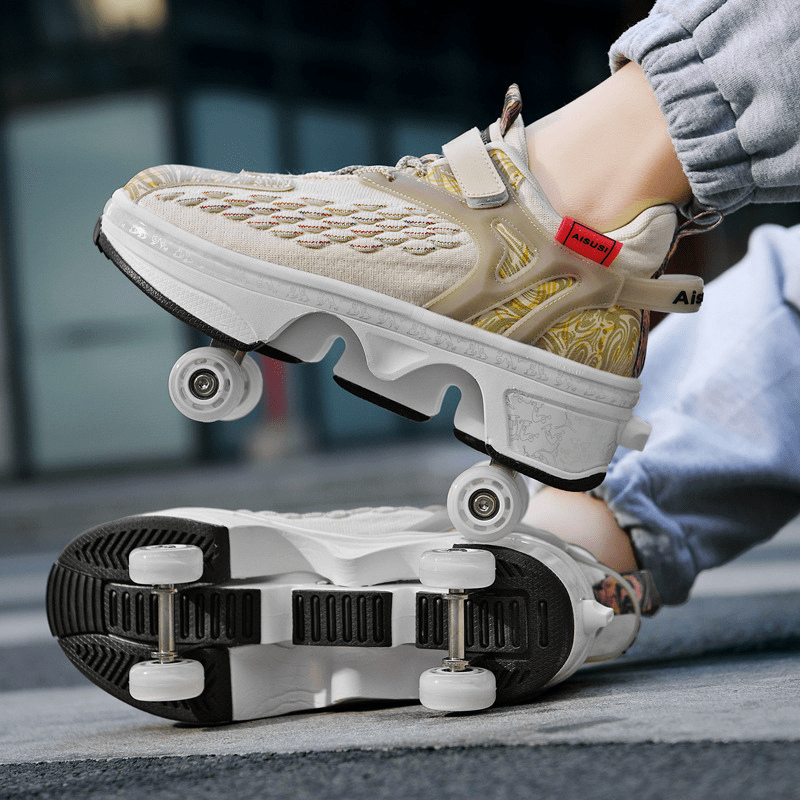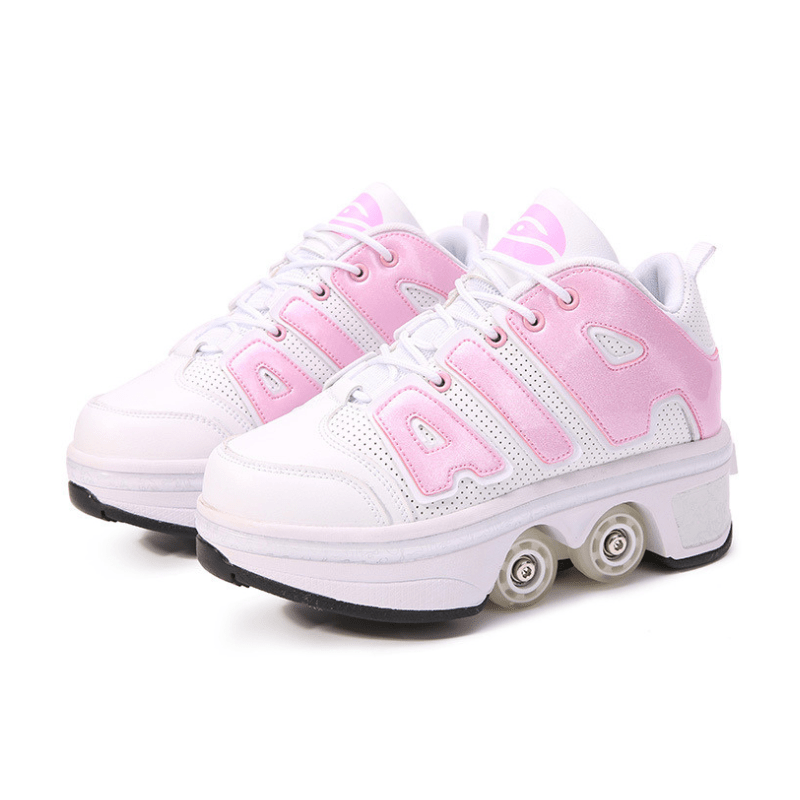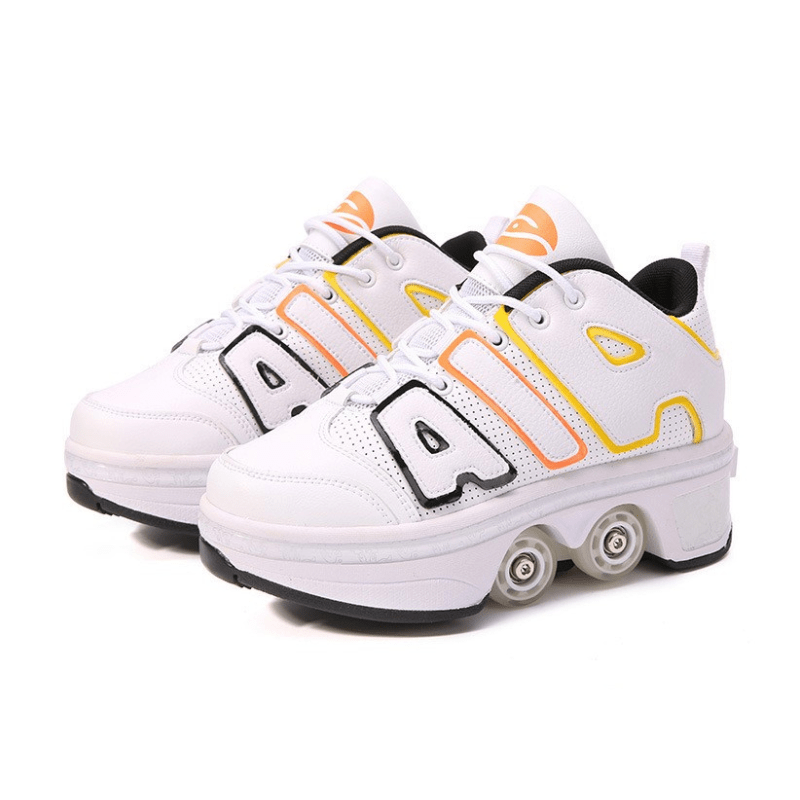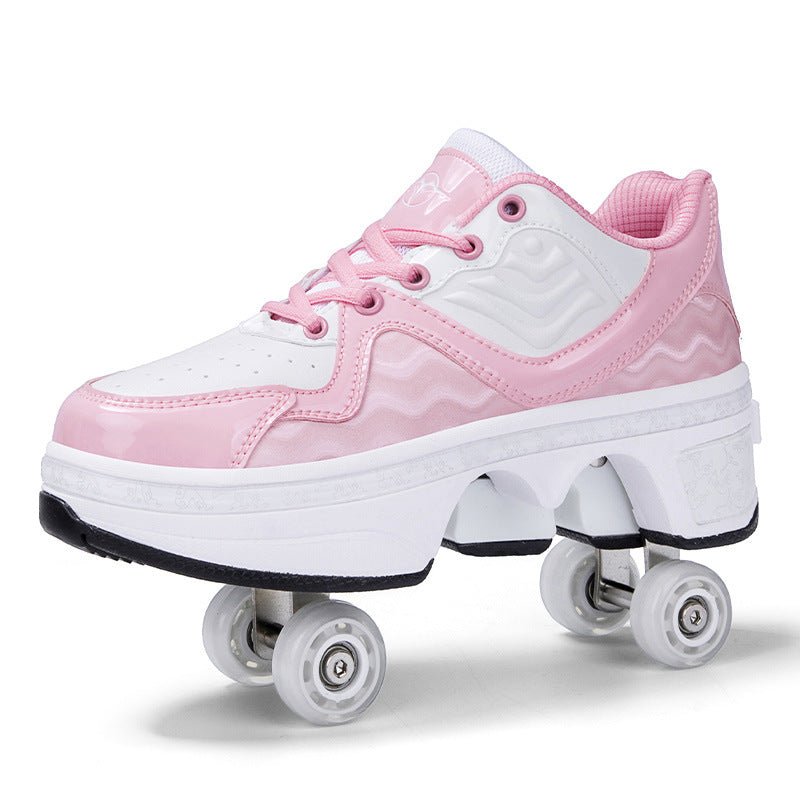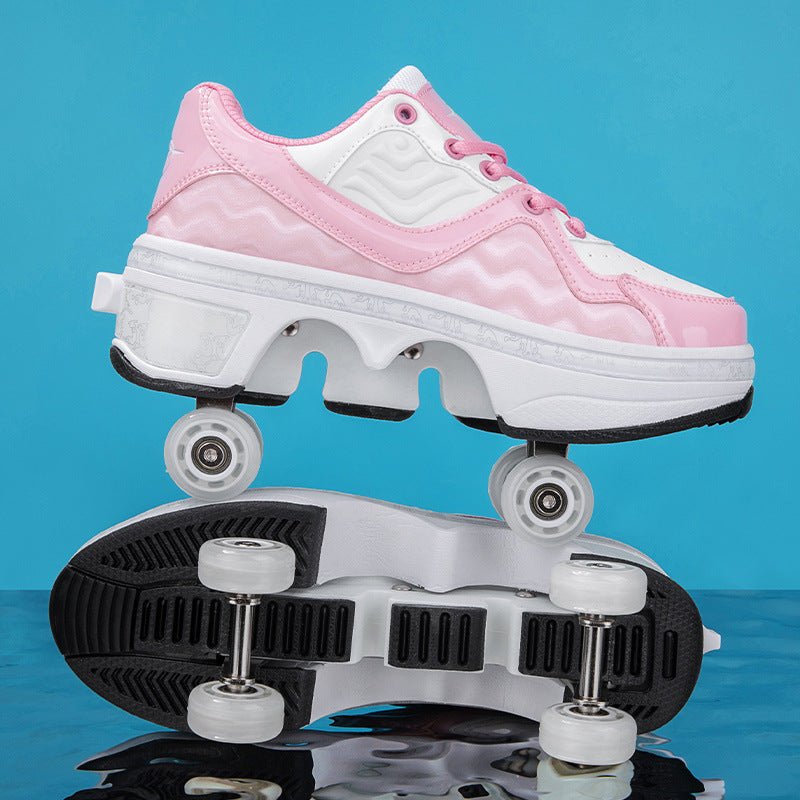4-Wheel Roller Skate Shoes vs Heel-Wheel Shoes: Which Is Right for You?
Trying to decide between 4-wheel roller skate shoes and heel-wheel shoes? This in-depth guide explains how each setup feels underfoot, who they’re best for (kids, teens, even adults), and what to look for in sizing, LEDs, bearings, and safety gear. To see real-world examples as you read, check out these two live models: the heel-wheel Kick Air LOW / LED and the 4-wheel-capable Kick Air MID / NEW LED.

Two paths to rolling fun: all-around stability with 4-wheel setups, or simple, quick glides with a single heel wheel.
What are 4-wheel roller skate shoes and heel-wheel shoes?
4-wheel roller skate shoes use two wheels in front and two in the rear for a skate-like stance. With a broader base of support, they emphasize stability, smoother gliding, and easier straight-line control. By contrast, heel-wheel shoes place a single wheel under the heel. You walk normally and then shift weight to the rear wheel for short, controlled glides—great for playful cruising and quick transitions between walking and rolling.
If you want a concrete reference while reading, open the heel-wheel Kick Air LOW / LED alongside the 4-wheel-capable Kick Air MID / NEW LED.
Benefits at a glance: who each style is best for
- 4-wheel roller skate shoes: Best for riders who value balance and stability, want longer rolls, and prefer a skate-like feel. Helpful for beginners who learn faster with a wider base, and for confident kids/teens who plan to cruise more than a few meters at a time.
- Heel-wheel shoes: Best for playful, stop-start glides, school runs, and everyday wear where walking is primary and rolling is the treat. Simple to learn on flat, smooth surfaces and easy to switch back to normal walking instantly.
LEDs add motivation and visibility to both formats. Both model examples—Kick Air LOW / LED and Kick Air MID / NEW LED—offer bright, rechargeable lighting and intuitive on/off controls.

Heel-wheel shoes let kids walk normally, then shift weight back for short, fun glides.
How to choose: sizing, wheels, LEDs, and bearings
Sizing & fit
Start with a precise foot measurement in centimeters. A secure midfoot and heel hold reduce wobble; toes should have gentle wiggle room without sliding. Low-top builds can feel more flexible around the forefoot and instep, while mid-tops hug the ankle for added support and confidence—especially useful for learning. If you’re browsing specific models, compare fit notes on the Kick Air LOW / LED and Kick Air MID / NEW LED pages.
Wheel configuration (and how they feel)
- Heel wheel (single rear wheel): Easiest for first-timers to grasp because walking is unchanged. Shift weight to the heel for a controlled glide; return to flat-foot for instant stability. See Kick Air LOW / LED.
- 4-wheel (two front, two rear): Feels like compact roller skates. Wider base = more balance, smoother rolling, and better straight-line tracking. A strong option for riders planning longer sessions. See the mid-top platform in Kick Air MID / NEW LED.
LEDs & power
Look for multiple light modes (steady, slow flash, fast flash), simple charging (USB), and clear on/off control. LEDs are great for dusk visibility and motivation—just make sure ports stay dry and unplug when fully charged. Both the Kick Air LOW / LED and Kick Air MID / NEW LED deliver bright output suitable for short evening sessions on safe, smooth surfaces.
Bearings, care & spare parts
Quality bearings keep rolls smooth and predictable. Wipe wheels dry after damp rides, brush away grit, and replace worn wheels early. Consistent maintenance helps both heel-wheel shoes and 4-wheel roller skate shoes feel steady and safe.
Real-model comparison: Kick Air LOW / LED (heel-wheel) vs Kick Air MID / NEW LED (4-wheel capable)
| Feature | Kick Air LOW / LED (Heel-Wheel) | Kick Air MID / NEW LED (Pop-Out Wheels) |
|---|---|---|
 |
||
| Ride feel | Walk normally; shift weight back to glide. Quick, playful bursts. | Skate-like stance with broader base; stable, longer glides. |
| Learning curve | Very approachable for first steps on smooth floors/paths. | Beginner-friendly with practice; stability helps progress. |
| Ankle support | Low-top flexibility; natural range of motion. | Mid-top wrap; added control and lateral support. |
| LEDs | Rechargeable LEDs; multiple modes. | Updated/bright LEDs; multiple modes. |
| Best for | Everyday walking with fun glides; school runs and quick play. | Kids/teens who want balance, smoother cruising, and skills growth. |
Tip: If you’re unsure which path to take, ask: “Do we want mostly walking with occasional glides, or more frequent rolling with skate-like balance?” For the first case, heel-wheel shoes are perfect. For the second, consider a mid-top platform like 4-wheel roller skate shoes.
Safety checklist (for both styles)
- Surface: Start on smooth, dry, low-traffic ground. Avoid wet tiles, gravel, steep hills, and roads.
- Gear: Helmet plus wrist, knee, and elbow protection—every session for newer riders.
- Progression: Practice balance against a wall or rail; learn controlled stops before longer rolls.
- Session length: Frequent 10–20-minute bouts build skill and confidence without fatigue.
- Maintenance: Keep wheels/bearings clean and dry; replace worn wheels early for consistent grip.
- Kick Air LOW / LED — pocket-friendly heel-wheel fun that keeps walking natural and glides easy to learn.
- Kick Air MID / NEW LED — mid-top support with a stable, 4-wheel path for longer, smoother cruising.
FAQ
Are 4-wheel roller skate shoes safer than heel-wheel shoes?
They offer a wider base and can feel more stable for straight-line gliding. Heel-wheel shoes are very safe too when used on smooth surfaces with protective gear and adult supervision for younger riders.
Which is easier for beginners?
Heel-wheel is often the quickest to grasp because walking is unchanged and gliding is brief and controlled. Many riders progress to 4-wheel setups for longer sessions as skills grow.
Do LEDs drain quickly?
Most modern LED systems are rechargeable and last multiple sessions per charge. Unplug after a full charge and keep ports dry to maintain battery life.
How should they fit?
Snug at the heel and midfoot with light toe wiggle. Mid-tops add ankle support and control; low-tops feel more flexible around the forefoot and instep.
What’s the best place to try them?
Start on smooth, dry, low-traffic surfaces—like indoor halls or flat park paths—before moving to longer outdoor sessions.



